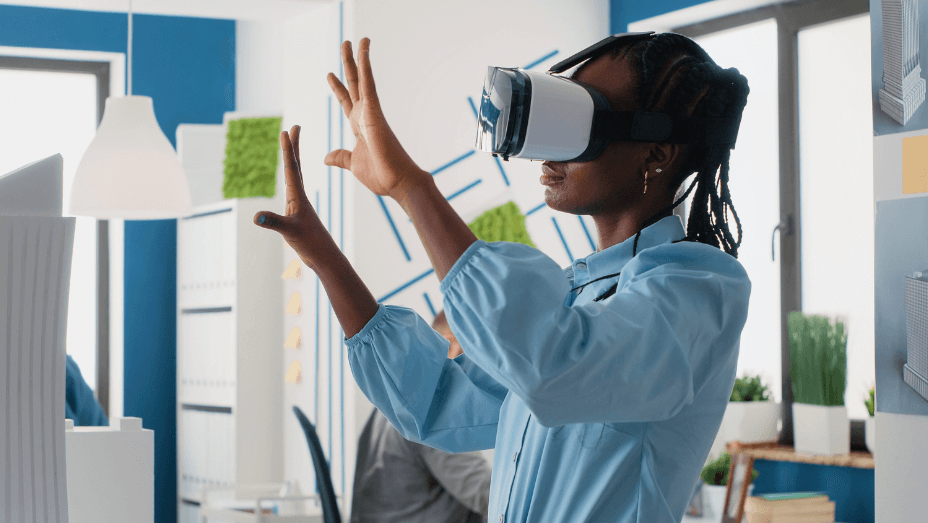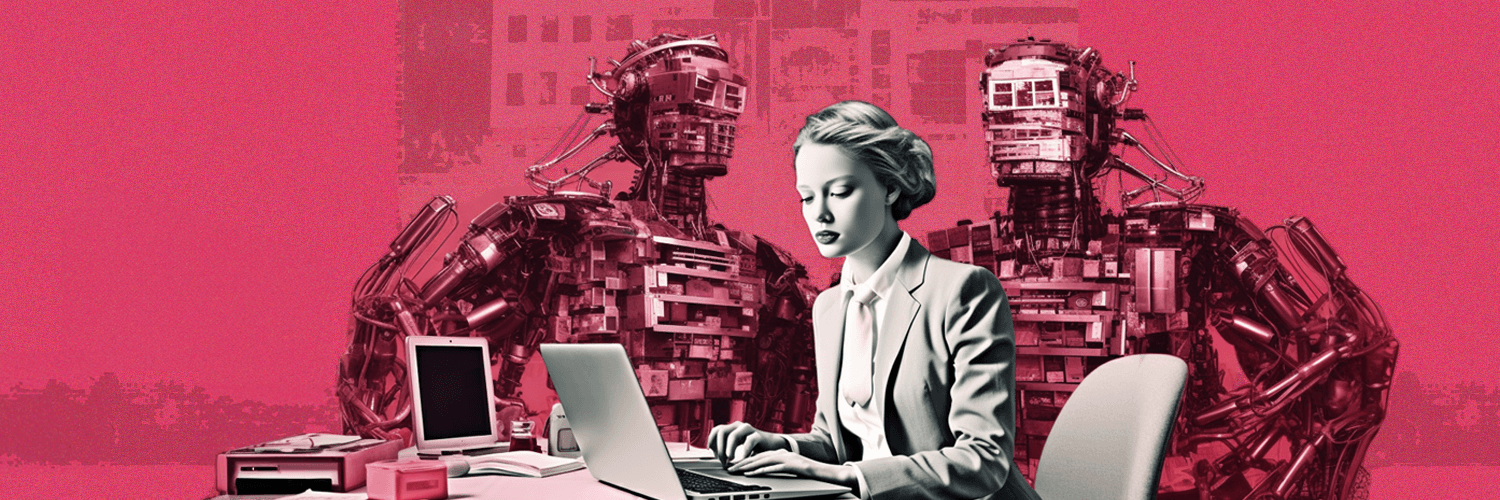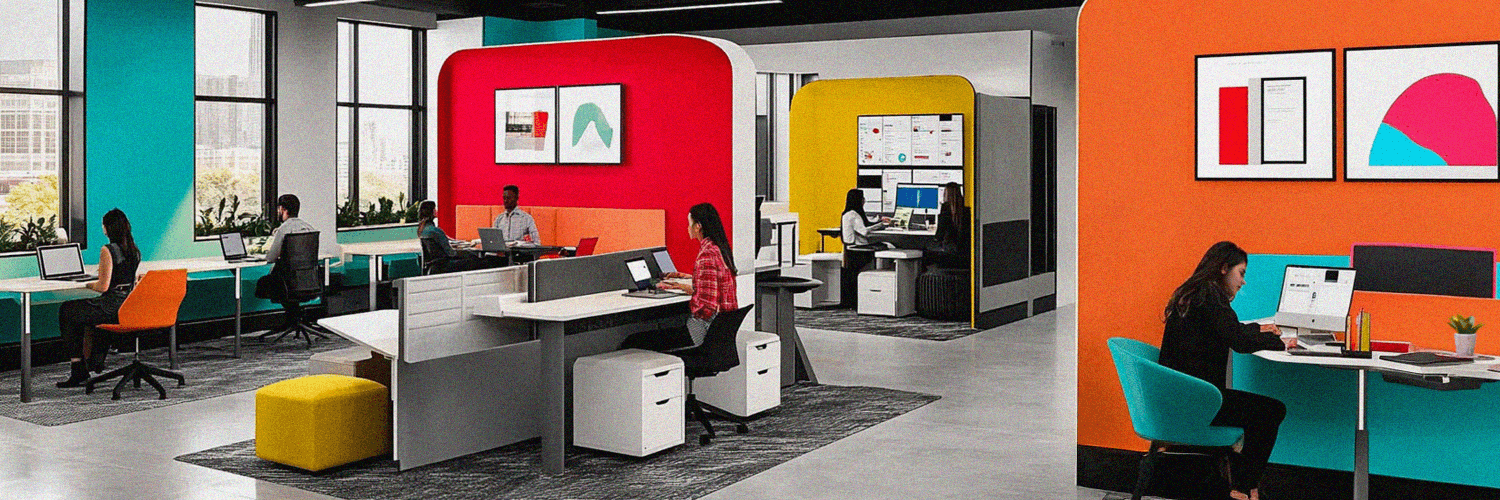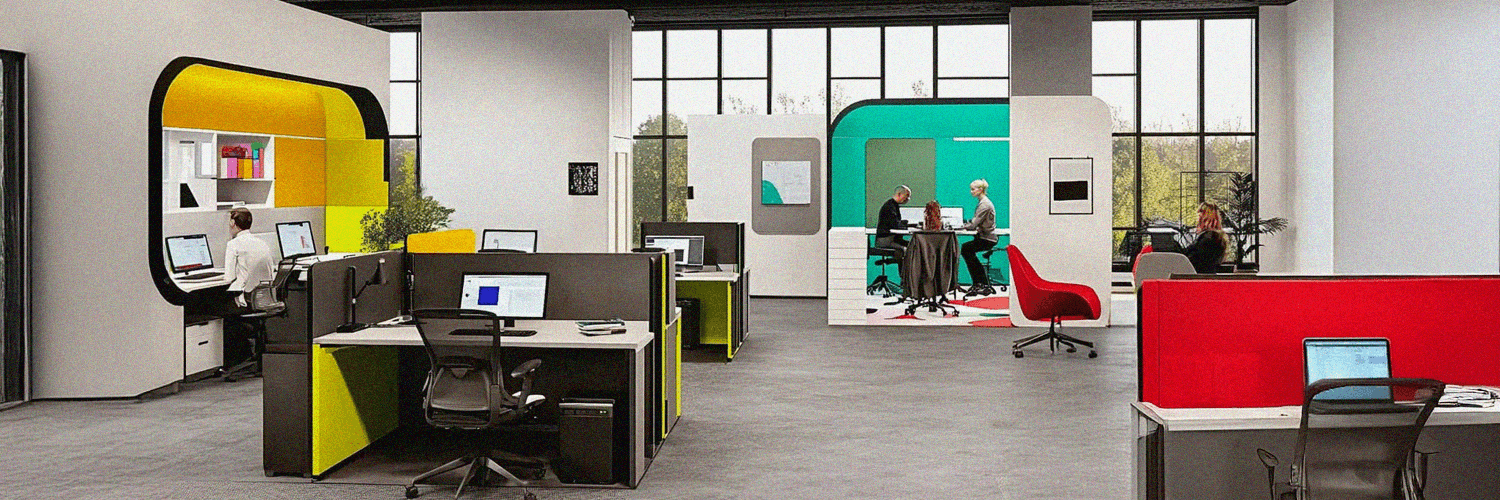“How can AI improve the employee experience in my organization?” Instead of approaching this question the standard way, let’s try some reverse engineering: “What leads to a poor employee experience in the first place?”
In other words, what makes your employees unhappy?
The answer? “Tedious, repetitive tasks, lack of purpose, few or zero growth opportunities, the dread of having to search for information across a maze of different systems…”
Overall, the sense they’re not making productive use of their time, monotonous and repetitive work, and poor work-life balance.
And employee experience AI helps you address precisely these causes of employee unhappiness.
You only need to… leverage it. To make use of its potential to make your employees happier.
Here’s how exactly.
TL;DR:
- AI can enhance the employee experience (EX) and benefit businesses.
- It has the potential to attract talent, boost productivity, improve customer experience, and enhance employer brand.
- Yet, companies implementing it into their workplace need to address specific AI challenges like bias, resistance to change, empathy, transparency, job loss, privacy, and ethics
- Best practices for implementing AI in the workplace involve engaging employees, gradual AI implementation, training, transparency, and monitoring of the AI systems.
- The aim is to balance employee well-being and organization benefits: cost reduction, efficiency improvement, higher productivity, better engagement, and increased innovation.
The Importance of Employee Experience
Before talking about employee experience AI, let’s see exactly how a positive (or negative) employee experience affects your business.
To put it more straightforward: how does a positive employee experience benefit your business?
It Helps You Attract and Retain Top Talent in Your Company
You do want to filter out job seekers and aim straight for the best talent for different positions in your company, don’t you?
Then a positive employee experience is the best filtering criterion for them. As top talent isn’t looking exclusively for above-average salaries.
They’re also evaluating the company culture, the learning and development opportunities, employee satisfaction level – all signals of a positive employee experience.
And these signals are the ones “responsible” for making the same valuable employees want to stick with you in the long run, too.
It Boosts Your Employees’ Productivity
An excellent employee experience is what will motivate your workers to do their best work. To support your company’s broader goals.
And it’s the one driving better teamwork, too. Leading not only to increased individual productivity but to improved team productivity, too.
Employees that are happy at work communicate and work better with their colleagues. They’re more open to solving problems, to generating creative ideas, and finding solutions within a team.
It Improves the Customer Experience
If your employees are disengaged and unhappy at work it will reflect in the customer experience they’ll deliver.
As these two are strongly connected.
If you want to improve your customer experience you need to make sure your employees have a great experience at work in the first place.
That they feel valued, trusted, motivated, and empowered. This way, they’ll be genuinely motivated to foster better client relationships and do their best work.
It Boosts Your Employer Brand
What weighs more on a candidate’s decision to join your company:
- the story you tell about your company?
- or your employees’ accounts detailing their experience at your organization?
That’s right…
A successful employer brand starts with a positive employee experience.
It Reduces Absenteeism and Presenteeism
Employees who genuinely love working in your company – who feel that they matter, who feel fulfilled at work – are more motivated to do their work.
As simple as that.
By creating a supportive and engaging work environment you minimize the risks of employees missing important deadlines and meetings. And impacting their teams’ global productivity due to their absenteeism.
You also reduce the risk of having them mentally elsewhere, worn out, and unmotivated.

The Impact of AI on Employee Experience
“How can AI improve employee experience?”
How exactly does an AI employee's ability to process large volumes of data and learn from them enhance the EX more precisely? Whether it’s automating workflows or utilizing advanced tools like text-to-video AI for creating quick training content, AI’s impact is transformative.
Let’s get to the bottom of the initial question and highlight the key opportunities for optimizing the employee experience in your company with the help of AI.
It Automates Repetitive Tasks: Employees Get More Productive & Efficient
An AI employee gets the most out of machine learning algorithms to identify patterns and carry out all those monotonous, routine tasks due to which your employees’ productivity and level of engagement can take a big hit.
With these repetitive tasks out of their way, they gain more time to focus on strategic and creative activities.
Not to mention that it boosts their overall job satisfaction.
By incorporating an Ai checker into these workflows, organizations can further enhance precision and consistency — ensuring automated tasks are completed accurately while freeing up employees to focus on higher-value, creative work.
And there’s more to AI and automation for improving the employee experience...
AI Helps Improve Entire Workflows
When talking about employee experience AI and the impact AI has on streamlining repetitive tasks, we should see those individual tasks globally.
As parts of whole workflows and systems.
With optimized business workflows set in place, your employees’ lives at work become simpler. And more rewarding.
The AI-powered tools at hand provide them with the right insights to constantly improve these workflows and grow more productive and more efficient.
More fulfilled with their work.
AI Forecasts Future Issues With the Existing Internal Processes
It helps your employees grow more proactive, more efficient.
For when you’re not using a great part of your time trying to predict possible future issues and you’re not constantly concerned about what might go wrong in the internal operations you can focus better on your tasks.
And free yourself of that mental load for… more strategic activities instead.
It Helps Personalizing the Employee Experience: Employees Grow More Engaged
With AI being able to analyze huge amounts of data about your employees – skills, performance, preferences, work history – you can create more personalized work and learning experiences.
As AI identifies skills gaps to be filled through customized training and growth opportunities to be pursued through customized professional development recommendations.
And it also makes it easier for you to assign projects in accordance with each employee’s skills.
All of which leads to your employees feeling more satisfied with their jobs. More valued. More motivated to seize the growth and development opportunities tailored to them specifically.
It Reduces Human Error: Employees Grow More Confident in Their Abilities
With manual work out of the picture (or at least the greatest part of it) and streamlined repetitive processes, you keep human error down to a bare minimum.
Which will not only make your employees more effective. But it will also boost their confidence in their skills, in their abilities, and… creative ideas.
And it will make them feel more confident to unlock their full potential at work.
It Improves and Accelerates Decision Making: Employees Grow More Efficient & Productive (More Confident, too)
“Real-time decision making” that is.
An AI employee can harvest massive amounts of data and deliver valuable insights and recommendations to your employees.
The result? More informed, data-driven choices and proactive decisions.
And faster decisions, too.
With AI-enabled technology at hand, your employees don't need to worry about manually collecting and analyzing data that’s up to date.
That saves time and mental energy.
It Helps to Create a Better Work-Life Balance: Employees Grow More Engaged, More Loyal… Happier
It’s a fact: when employees feel more in control of their work-life balance, they get more engaged and grow more loyal to the company they work for.
And AI can help with that.
How?
AI Helps Your Employees Better Prioritize Their Tasks
It categorizes their tasks based on importance and urgency so they know how to best prioritize them.
And it can also provide them with accurate insights into how much time they usually spend on specific tasks.
AI Helps Your Employees Manage Their Time More Effectively
AI-powered reminders remind them of approaching deadlines or meetings.
While other AI-powered tools give your employees data-driven recommendations on the best time to schedule their calls and other activities.
And any healthy work-life balance starts with good time management.
AI Enhances Employee Communication and Collaboration
In short: it provides the tools that enable your (remote) employees to work smoother with their co-workers and get things done. Better. Faster.
It Enhances Human Creativity and Innovation: Employees Feel More Motivated
Employee experience AI is all about helping employees reach their full potential.
Which gets them to feel fulfilled in their work life while your organization “reaps” the benefits that come with that.
But how does AI help foster innovation and unlock employees’ creative potential?
- With AI-driven tools analyzing tons of data for them and delivering them accurate, valuable insights, they can use these insights to… fuel their creative ideas.
- With AI automating mundane, time and energy-consuming tasks, they gain more time for creative activities.
And last but not least: employees can use AI technology to actually test their ideas.
To get accurate, real-time feedback they need to further adjust and refine their innovative solutions...

AI Tools and Technologies for Improving EX
Now that you have a clearer understanding of how AI will impact the future of work and life in general and the employee experience specifically, let’s see exactly what your “AI toolbox” should include for improving the EX in your company.
Here are AI tools and technologies you’ll want to consider for improving the EX in your company.
Machine Learning to Foster and Boost Innovation (and Motivation)
Machine learning can support your employees' creativity and inspire bigger, innovative ideas.
How? Since it can analyze huge volumes of data, identify patterns, predict issues that might occur, and give accurate feedback, your employees can:
- Come up with new hypotheses they might have missed and try different angles. With the tedious task of going through lots and lots of data and spotting patterns done through machine learning AI, they can jump right on generating new and new ideas.
- See the bigger picture and make associations between apparently unconnected data. ML will have already analyzed, filtered, and prioritized huge amounts of information needed for them to start… identifying uncommon associations.
Virtual Assistants to Better Handle Their Work-Life Balance
They’re the AI employees that can help your human employees stay organized, manage their time more efficiently, and better manage their workloads.
Natural Language Processing (NLP) to Support Customized Learning and Growth Experience
Here’s exactly how NLP helps you tailor the most suitable development experience for your employees:
- It collects employee feedback from multiple sources – phone calls, emails, third-party sites – analyzes it, and identifies areas of improvement
- It creates content tailored to the specific skills and knowledge gaps identified in the case of each employee, to their unique learning styles and preferences.
Chatbots to Enhance Operational Efficiency and Productivity
How do AI-powered chatbots make your employees more effective, more productive (and far less likely to get bored and disengaged)?
By automating their repetitive and routine tasks – data entry, meeting scheduling, basic coding, updating project statuses, messaging, and even content distribution
And by giving them easier and quicker access to the information they need to handle their tasks, to make decisions.
Predictive Analysis
Predictive analysis can:
- predict different outcomes of the various experiments and new projects your employees might initiate
- identify issues before they grow into actual problems
This way, your employees can make more informed decisions more confidently.
Virtual and Augmented Reality to Personalize the Learning Experience
By leveraging AI and VR you can tailor development programs more closely to your employees’ needs. And deliver more personalized training content.
This way, the learning experiences you provide them will be personalized to every employee’s style of learning and specific gaps.
The results? Your employees perform better in their roles, and they grow more engaged and more satisfied with their jobs.

Challenges of AI in the Workplace (And How to Address Them)
Yes, with the benefits of employee experience AI comes some challenges, too, that it’s important to be aware of.
So you can be prepared to address them and balance the opportunities of using AI in the workplace with the potential drawbacks that could translate into poorer EX.
Here are these challenges along with effective ways you can address them:
The Bias Challenge
For yes, biases can creep into AI, too. Which can deliver the existing biases and stereotypes coming from the (biased) data it’s been fed on.
But you can easily address this challenge quite easily by:
- testing the AI models before and after they’re developed
- feeding your AI systems with a wider diversity of representative data
- setting up clear and high standards for ethical AI development
- relying on synthetic data when training your AI models
- relying on fairness metrics to assess the fairness of your AI systems
The Change Resistance Challenge
Do expect some of your employees to resist change more than others. Not everyone will be as open to working with new technologies as you hope.
But there are solutions:
- Involve the employees in the change process right from the start
- Give them the why, the what, and the how of introducing the new AI-based tools and technologies into the workplace. Don’t just tell them they should incorporate them into their day-to-day activities
The Lack of Empathy Challenge
AI systems can easily be perceived as non-empathic. Or, at least, as not as empathic as humans are.
How can you address this?
Focus on creating more empathetic human-interactive AI.
AI that doesn’t merely deliver data and numbers in its interactions with your employees but communicates with your employees more individualistically.
The Lack of Transparency Challenge
Employees might be more resistant to using AI-driven systems when they can’t see how decisions are being made. Or what kind of data they based their recommendations on.
The solution? Be more transparent about how your AI systems actually work. About what data they’re using to make decisions and how they use it.
The Job Loss Challenge
“How AIi will impact the future of work and life?”
Answer: “AI has a huge potential for improving the employee experience in your organization. But it can also cause a lot of stress among your workers: people will fear that AI will be replacing their jobs in your company.”
And it will. At least some of them. This is a non-deniable impact of AI on employment.
But instead of being perceived as a cause of stress, your employees can look at it as an opportunity. With a little help from you to switch their perspective:
- Offer your employees learning and reskilling opportunities tailored for each one of them
- Incentivize them to participate in these trainings
- Offer them full support in their career development processes, encouraging them to change roles and take on new responsibilities
- Set goals to be achieved for each employee determined to reskill themselves for new roles
The Privacy Concerns
Some legitimate concerns, if you think about it, as your employees don’t know how exactly their data is used for feeding your AI systems.
And whether there are any “cracks” in how their data is being protected.
You have 2 effective solutions for dealing with their concerns:
- Ensure that the AI services vendors you partner with stick to their security protocols long after the contracts are signed
- Have your management separate AI from the analysis of other tech risks. This way, they can break down more easily and clearly any risks that the employee data can be compromised
Ethical Considerations
When weighing the pros and cons of employee experience AI, assessing the ethical implications of the AI tools and technology you introduce into your workplace – into your employees’ work lives – is a crucial step.
Ethical dimensions like security, fairness, and privacy.
For the AI systems you’ll put in place may:
- be exposed to biases
- stand the risk of discriminating against employees based on their health conditions or merely personal preferences
… if they’re not designed to account for factors like gender, race, or age.
Or if they’re left vulnerable to cyberattacks.
Here’s how to address these valid ethical concerns when adding an AI employee to your workspace:
- Set clear guidelines for using the different AI tools and AI technologies in your workplace. Guidelines that assess the transparency and accountability of these AI systems
- Give your employees proper training around the use of AI and its impact on the workplace. Also, be mindful of the way AI is used for driving critical decisions: promotions, recruiting, etc.
- Make sure the way AI is used in your company is consistent with its core values and specific mission. That it aligns with its broader objectives
AI and Employee Experience: Best Practices
Employee well-being. This should be at the center of all your decisions when designing and integrating AI systems into your EX.
How will those AI-driven tools impact their level of job satisfaction, their work-life balance, their level of stress, and their level of… happiness?
And you can’t keep their well-being central, at all times, unless you:
- involve your employees throughout your entire AI systems’ design process
- make sure those systems serve their needs as well as the business
Here’s how exactly – or a short list of 5 best practices to help you integrate AI into your employee experience:
- Get them involved: get your employees involved in the implementation process and make it clear to them how AI will be used in the workplace.
- Take baby steps: first, you’ll want to implement AI in small areas of your business and gradually expand its use.
- Train your employees around using AI tools at work: make sure they gain the proper skills to effectively use these tools
- Be transparent: prioritize transparency around how AI is used and about how your employees’ data is used to feed your AI systems at work
- Keep a close eye on your employee experience AI systems: monitor the AI you implement into your workplace to make sure it works as intended and doesn’t hurt the employee experience

How to Improve AI Awareness Among Employees?
Your employees might not be as aware of the AI applications in the workplace and of their potential to positively impact their own work experience as you think they are.
And you’ll want to address this lack of AI awareness in your company.
Here are the 4 best ways to improve awareness of AI – its use and its benefits at an employee and organizational level – among your employees:
- Launch an initiative to increase awareness of AI technology among your employees
- Offer proper (personalized) training, where employees can learn more about AI and its specific uses
- Foster AI advocates in your company: identify leaders who have the knowledge, experience, and… drive to propagate an understanding of AI among other employees
- Encourage your employees to experiment with AI tools, so they gain a first-hand understanding of how they work and actually experience AI’s impact on their own employee experiences
Final Thoughts
If there was one thing you had to take away from this article, this should be the one:
The AI solutions you integrate into your workplace should benefit BOTH your employees and your business. In this particular order.
You want employee experience AI to make life at your workplace easier and more satisfying by:
- Automating monotonous, repetitive tasks
- Giving employees access to perfectly personalized development and learning programs to support their growth
- Improving decision-making
But while going for these goals, you want your AI systems to be designed and perfected so that they’re immune to biases.
And you want to make all AI uses transparent to your employees.
Only after you’ve thicked these goals and challenges off your list you can expect to reap the business benefits you’re going for:
- Cost reduction
- Improved efficiency
- Higher productivity
- Improved employee engagement
- Improved employee retention
- Increased innovation











